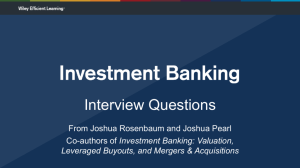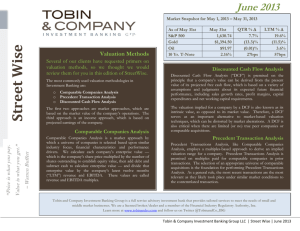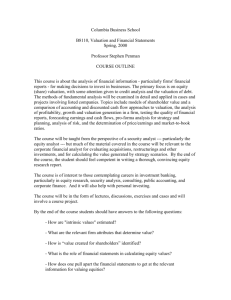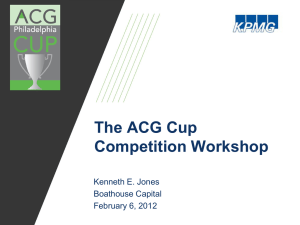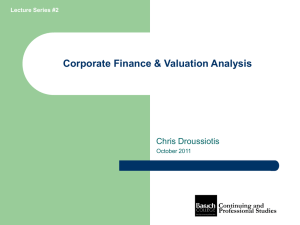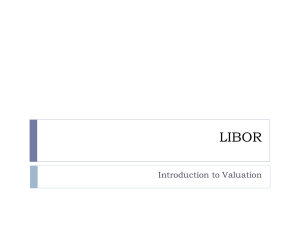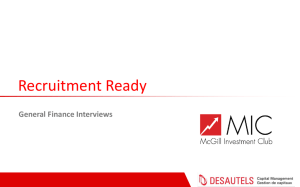Finance Interview Prep: Tips, Questions & Valuation
advertisement
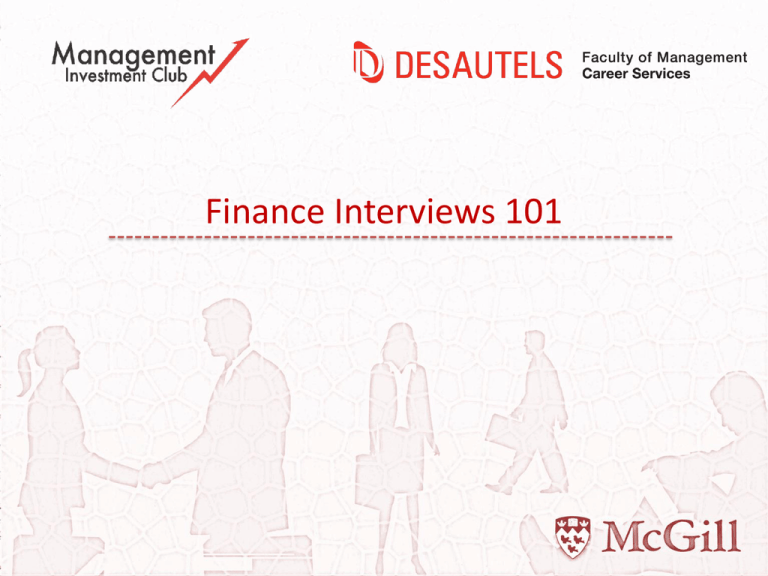
Finance Interviews 101 Introduction Danielle Dagenais Finance Career Advisor Desautels Faculty of Management danielle.dagenais@mail.mcgill.ca Mak Doric Investment Banking Full-Time Analyst Goldman Sachs, Calgary mak.doric@mail.mcgill.ca Agenda Interview Format General Interviewing Tips Behavioural Questions Valuation The Infamous Accounting Question Sample Technical Questions Behavioural Interview Format First Round • 30-45 minutes • Behavioural and lots of technical • One to six interviewers Second Round • 3-4 hours • Even more technical (reactions under fatigue/pressure) • One, two, or panel interviewers The First Half Minute A B C The First Half Minute A B C The First Half Minute Posture Handshake Expression Eye Contact Walk Cocktails & Dinners Make it about them Circulate Questions to ask: • • • • • • • • What made you choose [insert firm’s name]? What do you find most challenging in your work? How did you make your way to investment banking? In what industries does your office see the most dealflow? Would I go to one industry group or be a generalist? How would you describe the culture of your office? What is the most important quality for an analyst to have? Ask questions about your interviewer : Show you listen e.g. “How did the New York office compare to Toronto?” Cocktails & Dinners Do not: • • • • Ask nerdy finance questions Talk about how bad the markets are Talk about what you do not know Be cocky Do: • Expect out of the blue questions about the economy and investing • Show an interest in others • Use your other interests conversationally COME ACROSS AS AN INTERESTING AND AMBITIOUS PERSON, FUN AND ENJOYABLE TO WORK WITH Answering Questions STRUCTURE PAUSE REASON TONE STRATEGY SPEED Organize your answers and use your fingers Take the time to think about the question before answering Walk through your logical thinking process Be confident and comfortable, calm, not arrogant Differentiate, summarize and be aware of reaction Be intelligible - particularly if you have a foreign accent Walk me through your CV? THE GOOD, What is your story? 1-2 minutes: • Logical flow • Reasons for your choices • Progression • Successes • Wrap up the package Inexorable path to investment banking THE BAD… AND THE UGLY. I did this, this and that in school and then I had this, this and that summer job. Oh! And I also had this, this and that extracurricular. Here, I brought you a copy. Walk me through your CV? THE GOOD, THE BAD… AND THE UGLY. Structure in 5 points: 1. The beginning : Where are you from? University? 2. The finance “spark” : Person? Club? Class? 3. Growing interest : Jobs/internships/activit ies? 4. Now : Why this bank, and why now? 5. The future : What do you want to be later? I did this, this and that in school and then I had this, this and that summer job. Oh! And I also had this, this and that extracurricular. Here, I brought you a copy. Why investment banking? THE GOOD, THE BAD… AND THE UGLY. Make it personal Differentiate Be opportunistic Structure! Fit Some ideas: • Intense learning • Working with brilliant people • Loving financial markets • Preferring project work • Multi-tasking, pressure… I like finance, I would like to live in NY and investment banking sounds exciting. I would like to make piles of money to retire young. Tell me about a stock you love? THE GOOD, I love X stock because the CEO there is the best … and the products are amazing... Also, I think the market is not recognizing… because it trades at… and it has the potential to go to… Add’l comment if needed: a few key business metrics THE BAD… AND THE UGLY. I love X stock because the CEO there is the best … and the products are amazing... I don’t have time to follow stocks while in school. Where did the DJIA close yesterday? THE GOOD, THE BAD… AND THE UGLY. 12 000? Han? 13307, up 15… the stock market traded up on job creation and a drop in the unemployment rate to 8.1%. Add’l comment if needed: Gold rallied and Silver jumped… Top stocks were… Where did the TSX close yesterday? THE GOOD, THE BAD… AND THE UGLY. No idea. S#&$t? I did not look at Toronto but in NY, the Down Jones was at… Prepared blurb… Usually Toronto about mirrors this unless something major happens with resources or energy. What is underwriting? THE GOOD, THE BAD… AND THE UGLY. Underwriting is the process by which investment bankers issue securities to raise capital from investors on behalf of governments and corporations. It generally works like this… the lead manager… the syndicate… Securities are sold to... The distribution risk… The credit crisis… Underwriting is when an investment bank helps companies raise money by issuing securities. Underwriters are authors from Australia. What goes into a pitch book? THE GOOD, THE BAD… AND THE UGLY. There are different kinds of pitch books, some introducing your bank and giving updates to potential clients, or others proposing deals, sell-side M&A, buy-side M&A, IPOs, restructurings, debt issuances…, and so on. So what goes in each varies. But in general, one can expect to see… A pitch book is a presentation made to a client about what the firm does. Advice about how to improve your curveball. Other classics to prepare Did you listen in the company sessions: • Why our firm? • Tell me about a deal our firm is involved in? Key experience stories: • • • • • Tell me about a time you displayed leadership? How do you perform in teamwork? When did you demonstrate work ethics? What is your weakness? How do you deal with conflict? Much easier prepared than not: • Why IB and not Sales & Trading? Investment Management? • If I made you an offer, would you accept it? • Tell me about current financial events? Questions come in families Walk me through your CV? • • • • • • Tell me about yourself? Why should I pick you? Tell me about your experience? What should I know about you? What would make you a good XYZ? What brings you here What are you most proud of? • • • • What was the greatest challenge you faced? Tell me about a time you demonstrated leadership? How do you overcome difficulties? What is your greatest quality? Thank You Note Dear Mr Sachs, Thank you for giving me the opportunity to discuss the opening for a market analyst position. It was a pleasure to meet you and Mrs Robinson, as well as to learn more about XX Corporation. I especially appreciated hearing about your own experience with as an analyst at XX. The dynamic environment your company offers is particularly attractive. I feel that this is the type of environment in which I would perform very well. I look forward to hearing from you. Please feel free to contact me with any questions regarding my candidacy. Sincerely, Jo Blo Resources Career Services: • www.mcgill.ca/desautels-career Vault Guide to Finance Interviews • Interview preparation with a counselor Google (!) • Mergers and inquisition • Banking or bust News: • Wall Street Journal, Bloomberg, Financial Times, etc. Questions? Technical Questions Accounting Questions If you were on a desert island and could only have access to 1 of the statements, which one would you choose? The C/F statement gives a true picture of how much cash the firm is actually generating, independent of non-cash expenses. “Cash is king” If I let you choose 2 statements, which ones would you choose? Would you still pick the cash-flow statement? The C/F statement can be created from the I/S and the B/S assuming you have access to before and after versions of the B/S 26 Accounting Questions How would a $10 increase in depreciation affect the financial statements? Income Statement Cash-Flow Statement Balance Sheet Operating Income -$10 Net Income -$6 PP&E -$10 Tax (40%) $4 Depreciation $10 Cash $4 Net Income -$6 Change in Cash $4 Equity -$6 27 Accounting Questions A company switches from LIFO to FIFO method in an inflationary environment; how does it affect statements? Operating income and earnings will be overstated (lower COGS). Inventory on B/S will also be higher as “cheap items” are sold first. C/F will be higher due to increased earnings, offset by change in NWC. A company has had positive EBITDA for past 10 years, but it recently went bankrupt. How is that possible? The company is spending too much on capex (not included in EBITDA), high interest expense, credit crunch, one-time charges 28 Valuation (a classic) Walk me though a DCF WACC = r_e * E/V + r_d * D/V * (1-T) - How to impress: discuss assumptions with cost of debt and equity, mention challenges with “in-between” securities like preferred shares and convertibles, challenges with tax rates UFCF = EBIT (1-T) + D&A – Capex – Changes in NWC - How to impress: discuss the fact that this is value available to all stakeholders in the firm and potentially how to get to LFCF and calculate the equity value 29 Valuation (a classic) Walk me though a DCF (continued) Terminal Value - Multiple: most commonly used method in industry, typically EV/EBITDA is used based on comparables (impress by using companies that will be comparable in 5-10 years) or normalized historical average - Growing perpetuity: typically a measure like GDP growth will be used Enterprise Value = Equity Value + Debt + Preferred Shares + Minority Interest - Cash - How to impress: Discuss convertibles, operating leases and other debt like instruments 30 Valuation (a classic) Walk me though a DCF (continued) Pros/Cons - Pros: Intrinsic valuation, can be used to back test how much a company needs to grow to achieve a certain stock price, investors can see where value comes from - Cons: too many assumptions (importance of sensitivity analyses), “garbage in, garbage out”, does not explain why a company is not trading where it should be, should not be used for companies with unpredictable/unstable cash-flows Mid-year convention - Good way to impress interviewer! 31 DCF Summary Page 32 Relative Valuation What makes a good comp? - Industry Size Growth Stage Geography Capital Structure Which metrics to use? - EV / EBITDA (numerator and denominator for equity and debt) P/E (numerator and denominator for equity only) What if a company has negative EBITDA? - Climb up the income statement (EV / Revenues) 33 Relative Valuation – Basic Steps 1. Determine the target company’s EPS, EBITDA, and Sales for current year and possibly forward year (using research analyst estimates) 2. Determine the set of comparable companies (comp universe) and their trading multiples • Similar companies based on industry, size, business model, risk, capital structure – anything you can control • Separate lists if company is a conglomerate 3. Multiply average industry multiple by current or forward performance of target company to determine the relative value of the firm: Mavg x Operating Metric = Enterprise Value OR Equity Value Relative Valuation – Pros & Cons Stock prices are determined by relative values Fewer assumptions than for DCF Not a gauge of intrinsic value • Reflects the market’s current opinions on value – average could be skewed based on company-specific factors and economic environment • Only values companies when valued the same way as their peers Often difficult to find true comparables • Can use sum-of-the-parts valuation (NAV) for a diversified corporation, which is a weighted-average of each division under specific industry multiples Sample Comp Sheet Comparables Table U.S. Auto Manufacuturers GENERAL MOTORS FORD MOTOR DAIMLER AG Japanese Auto Manufacuturers TOYOTA MOTOR NISSAN MOTOR HONDA MOTOR MAZDA MOTOR SUZUKI MOTOR MITSUBISHI MOTORS Japanese Auto OEMs Average European Auto Manufacuturers VOLKSWAGEN RENAULT BAYERISCHE MOTOREN WERKE PEUGEOT FIAT European Auto OEMs Average Korean Auto Manufacuturers KIA MOTORS CORPORATION HYUNDAI MOTOR General Motors Global Auto OEMs Average Mkt Cap ($B) Price ($) Debt ($B) Debt/EBITDA Profit Margin (%) ROE (%) P/E 2013 P/E 2014 37.99 49.68 58.66 27.80 12.95 54.93 5.2 104.3 111.7 0.15x 7.46x 6.94x 3.0 4.4 7.5 17.1 36.6 14.6 8.28x 9.38x 8.95x 6.42x 7.83x 7.78x 172.5 41.59 66 8.25 12.59 5.97 50.03 9.20 36.43 2.75 22.44 0.99 148.9 56.2 52.9 8.8 5.1 3.7 6.05x 4.66x 4.28x 7.87x 1.93x 2.65x 1.9 2.4 3.2 3.9 1.1 -3.0 7.2 9.8 8.1 7.6 6.2 16.70x 10.65x 15.34x 26.47x 16.16x 29.90x 19.20x 11.54x 8.04x 10.58x 10.66x 12.73x 11.74x 10.88x 89.75 18.59 188.60 62.88 155.3 43.6 4.82x 8.18x 3.4 5.0 32.2 7.3 6.76x 6.15x 5.85x 4.89x 56 2.58 6.68 87.32 7.27 5.34 91.7 43.0 36.8 5.79x 14.09x 3.51x 5.8 -16.2 0.5 17.8 -42.4 3.9 8.70x 8.43x 10.01x 7.91x 6.04x 6.30x 20.09 43.96 49.53 199.55 3.6 42.5 0.85x 4.13x 8.2 10.1 25.5 21.0 5.90x 6.42x 5.34x 5.89x 37.99 27.80 5.2 0.15x 3.0 17.1 11.5 8.28x 12.52x 6.42x 8.29x 36 Precedent Transactions – Overview Value of a company if it were to be taken over by another company (i.e. take-out value) Precedent transaction values should always yield higher values than relative valuation • Historical take-over premiums are 20-30% Not relevant if company is under certain scenarios (company is family-controlled and not looking to sell, etc.) Precedent Transactions – Basic Steps 1. Find historical takeovers within industry • Look for similar transaction size, and most recent first 2. Try to cover at least one economic cycle in terms of precedent transactions, as some takeover premiums might reflect a takeover boom in an industry 3. Multiply relevant multiples (P/E, EV/EBITDA, EV/Sales, etc.) by company figures to obtain the firm’s takeover value Precedent Transactions – Pros & Cons Often very relevant, especially for undervalued firms Reflects how much the company would be worth in the eyes of its industry peers Often used when firm is selling off a division Only useful if firm will consider takeover Precedent transaction values are often higher than intrinsic value (reflect over-payment in takeover transactions) Sample Technical Questions What are other valuation methods? If a company with a higher P/E acquires a company with a lower P/E, is this an accretive or dilutive merger? Why would an acquirer be willing to pay a premium to the current trading price? What method of valuation would result in the highest value? Why? What is minority interest? Why do we add it to the Enterprise Value formula? What makes a good LBO target? How do you value a company with negative historical cash flows? Two companies have the same balance sheet and income statement, yet company A is trading at a significant premium to company B. Why could this be the case? Sample Technical Questions Cont. Why can’t you use EV/Earnings or Price/EBITDA as valuation metrics? What is cheaper, debt or equity? If you own a start-up mining company in Canada and you require additional capital, would you rather finance your company with debt or equity? Why? What would have a greater impact on the value of a firm: a $1,000,000 rise in FCFF for the next five years, or a $500,000 rise in the terminal value FCFF? What are the two types of synergies? Which ones are more credible? What are break-even synergies? Calculate the real interest rate using the nominal and inflation rate. What is a yield curve? What is the duration of a zero-coupon 10-year bond? Brainteasers How many oranges are consumed in Canada annually? You have a hose along with a 3 liter bucket and a 5 liter bucket. How do you get exactly 4 liters of water? Brainteasers Interviewers are not looking for you to answer the question immediately, it’s not a test of smarts Do not panic! Logically think through the question, interviewers are analyzing your capacity to think logically in stressful situations Think out loud, don’t sit in silence Ask questions if you’re confused but totally stumped (but make sure to listen to the answer well) Sometimes thinking backwards is the key to many brainteasers Don’t feel rushed, work through everything and they may help you along the way Speak confidently and clearly You don’t have to come up with an absolute correct answer, they are usually looking more for the way you approach the question Questions?
